Mercedes-Benz
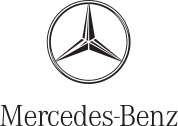 |
|
| Type | Division of Daimler AG |
|---|---|
| Industry | Automotive industry |
| Founded | 1881 |
| Founder(s) | Karl Benz Gottlieb Daimler |
| Headquarters | Stuttgart, Germany |
| Area served | Worldwide (except Mercedes-Benz vehicles and services with other distributors worldwide) |
| Key people | Dieter Zetsche, CEO |
| Products | Automobiles Trucks Buses Internal combustion engines |
| Services | Automotive financial services |
| Parent | Daimler AG |
| Website | Mercedes-Benz.com |
Mercedes-Benz (German pronunciation: [mɛʁˈtseːdəs ˈbɛnts]) is a German manufacturer of automobiles, buses, coaches, and trucks. It is currently a division of its parent company, Daimler AG (formerly DaimlerChrysler AG), after previously being owned by Daimler-Benz. Mercedes-Benz has its origins in Karl Benz's creation of the first petrol-powered car, the Benz Patent Motorwagen, patented in January 1886,[1] and by Gottlieb Daimler and engineer Wilhelm Maybach's conversion of a stagecoach by the addition of a petrol engine later that year. The Mercedes automobile was first marketed in 1901 by Daimler Motoren Gesellschaft. The first Mercedes-Benz brand name vehicles were produced in 1926, following the merger of Karl Benz's and Gottlieb Daimler's companies into the Daimler-Benz company.[1] Mercedes-Benz has introduced many technological and safety innovations that have become common in other vehicles several years later.[2] Mercedes-Benz is one of the most well-known and established automotive brands in the world, and is also the world's oldest automotive brand still in existence today.
Contents |
History
Business alliances
Studebaker-Packard
In 1958, Mercedes-Benz entered into a distribution agreement with the Studebaker-Packard Corporation of South Bend, Indiana (USA), makers of Studebaker and Packard brand automobiles.[3] Under the deal, Studebaker would allow Mercedes-Benz access to its dealer network in the U.S., handle shipments of vehicles to the dealers, and in return, receive compensation for each car sold. Studebaker also was permitted to use the German automaker's name in its advertisements, which stressed Studebaker's quality over quantity.
When Studebaker entered into informal discussions with Franco-American automaker Facel Vega about offering Facel Vega Excellence model in the United States, Mercedes-Benz objected to the proposal. Studebaker, which needed Mercedes-Benz distribution payments to help stem heavy losses, dropped further action on the plan.
Mercedes-Benz maintained an office within the Studebaker works in South Bend from 1958 to 1963, when Studebaker's U.S. operations ceased. Many U.S Studebaker dealers converted to Mercedes-Benz dealerships at that time. When Studebaker closed its Canadian operation and left the automobile business in 1966, remaining Studebaker dealers had the option to convert their dealerships to Mercedes-Benz dealership agreements.
Subsidiaries
Mercedes-Benz AMG became a majority owned division of Mercedes-Benz in 1998.[4] The company was integrated into DaimlerChrysler in 1999,[5] and became Mercedes-Benz AMG beginning on 1 January 1999.[6]
Quality rankings
Since its inception, Mercedes-Benz had maintained a reputation for its quality and durability. Objective measures looking at passenger vehicles - such as J.D. Power surveys, demonstrated a downturn in reputation in this criteria in the late 1990s and early 2000s. By mid-2005, Mercedes temporarily returned to the industry average for initial quality, a measure of problems after the first 90 days of ownership, according to J.D. Power.[7] In J.D. Power's Initial Quality Study for the first quarter of 2007, Mercedes showed dramatic improvement by climbing from 25th to 5th place, surpassing quality leader Toyota, and earning several awards for its models.[8] For 2008, Mercedes-Benz's initial quality rating improved by yet another mark, now in fourth place.[9] On top of this accolade, it also received the Platinum Plant Quality Award for its Mercedes’ Sindelfingen, Germany assembly plant.[9] As of 2009, Consumer Reports of the United States has changed their reliability ratings for several Mercedes-Benz vehicles to "average", and are recommending the E-Class and the S-Class.[10]
Corporate average fuel economy
In the United States, Mercedes-Benz was assessed a record US$30.66 million for their decision to not meet the federal corporate average fuel economy standard in 2009.[11] Certain Mercedes-Benz cars including the S550, and all AMG models sold in the United States also face an additional gas guzzler tax.[12]
In 2008, Mercedes had the worst CO2 average of all major European manufacturers, ranking 14th out of 14 manufacturers.[13] Mercedes was also the worst manufacturer in 2007 and 2006 in terms of average CO2 levels, with 181 g and 188 g of CO2 emitted per km, respectively.[14]
Production
Besides its native Germany, Mercedes-Benz vehicles are also manufactured or assembled in:
- Argentina (buses, trucks and the Sprinter van. The first Mercedes-Benz factory outside of Germany)[15]
- Austria (G-Class)[16]
- Bosnia and Herzegovina
- Brazil[17] (buses, trucks, C-class passenger cars (export only), established in 1956)
- Canada
- Egypt: Egyptian German Automotive Company
- Ghana (buses, trucks, taxis)
- Hungary (construction of a new plant in the country announced on 18 June 2008, for the next generation A- and B-Class)[18][19]
- India[20]
- Indonesia[21]
- Iran
- Malaysia[22]
- Mexico
- Nigeria[23] (buses, trucks, utility motors and the van Sprinter)
- Spain (Irun)
- South Africa[24]
- South Korea (Mercedes-Benz Musso and MB100 models manufactured by SsangYong Motor Company)
- Thailand (assembly of C, E and S class vehicles by the Thonburi Group)[25]
- Turkey[26]
- United Kingdom (The SLR sports car is built at the McLaren Technology Centre in Woking).Brackley, Northamptonshire, United Kingdom Mercedes Grand Prix Factory
- USA The Mercedes-Benz M-Class Sport Utility, the R-Class Sport Tourer, and the full-sized GL-Class Luxury Sport Utility Vehicle are all built at the Mercedes-Benz production facility near Tuscaloosa, Alabama.[27]
- Vietnam
Models
Current model range
Mercedes-Benz has a full range of passenger, light commercial and heavy commercial equipment. Production is on a global basis. The Smart marque of city cars has also been part of the Mercedes-Benz Group since 1994.
Passenger cars
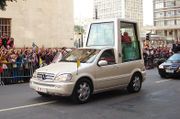
The following passenger vehicles were in production in 2010:
- A-Class - subcompact
- B-Class - people carrier
- C-Class - sedan (saloon), sports coupé (CLC), and estate
- CL-Class - coupé
- CLS-Class - 4 door coupé
- E-Class - sedan (saloon), coupé, convertible, and estate
- G-Class - 4WD cross-country vehicle
- GL-Class - SUV
- GLK-Class - SUV
- M-Class - SUV
- R-Class - crossover minivan
- S-Class - sedan (saloon)
- SL-Class - roadster
- SLK-Class - roadster
- SLR McLaren - hardtop supercar
- SLS AMG - luxury grand tourer
Trucks
Mercedes-Benz is one of the world's largest manufacturers of trucks.
Buses and vans
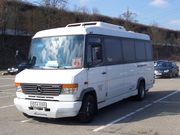
Mercedes-Benz also produces buses, mainly for Europe and Asia. Mercedes-Benz produces a range of vans. The first factory to be built outside Germany after WWII was in Argentina. It originally built trucks, many of which were modified independently to buses, popularly named Colectivo. Today, it builds buses, trucks and the Sprinter van.
Significant models produced
- 1928: SSK racing car
- 1930: 770 "Grosser Mercedes" state and ceremonial car
- 1934: 500 K
- 1936: 260 D World's first diesel production car
- 1936: 170
- 1938: W195 Speed Record-breaker
- 1951: Mercedes-Benz 300, knownly as "Adenauer Mercedes"
- 1953: "Ponton" models
- 1954: 300SL "Gullwing"
- 1959: "Fintail" models
- 1960: 220SE Cabriolet
- 1963: 600 "Grand Mercedes"
- 1963: 230SL "Pagoda"
- 1965: Mercedes-Benz S-Class
- 1966: 300SEL 6.3
- 1968: W114 "new generation" compact cars
- 1969: C111 experimental vehicle
- 1972: Mercedes-Benz W107 350SL
- 1974: 450SEL 6.9
- 1974: 240D
- 1976: 300D
- 1979: 500SEL and G-Class
- 1983: 190E 2.3-16
- 1986: First 'E-Class'
- 1991: 600SEL
- 1993: First 'C-Class'
- 1995: First 'Joint Mercedes-Benz & AMG' (C43 AMG)
- 1995: Mercedes-Benz SL73 AMG, 7.3 V12 (biggest engine ever put in a Mercedes-Benz)
- 1996: Mercedes-Benz Renntech E7.4RS
- 1996: Mercedes-Benz CLK
- 1997: Mercedes-Benz SLK
- 1997: Mercedes-Benz M-Class
- 2004: Mercedes-Benz SLR McLaren
- 2004: Mercedes-Benz CLS
- 2007: E320, GL320 Bluetec, ML320 Bluetec, R320 Bluetec
- 2010: Mercedes-Benz SLS AMG
McLaren cars

Mercedes-Benz has also produced a limited-production sports car with McLaren Cars, an extension of the collaboration by which Mercedes engines are used by the Team McLaren-Mercedes Formula One racing team, which is part owned by Mercedes. The 2003 Mercedes-Benz SLR McLaren has a carbon fibre body with a 5.4 litre V8 supercharged engine. This is the same cylinder block as featured in SL55 AMG and the CLS55 AMG, though modified to give 460 kilowatts (625 PS; 617 bhp) and 780 newton metres (575 ft·lbf) of torque. The SLR has a maximum speed of 337 kilometres per hour (209.4 mph) and costs approximately US$500,000. Due to European pedestrian-protection regulation, McLaren decided to cease production of the SLR in 2009.[28]
Car nomenclature
In 1994 (starting with the 1994 models), the traditional nomenclature of Mercedes-Benz vehicles changed. Since the early days of the company, the name would be in the form of (for example) 500E where the engine displacement made up the first three numbers and the last letter(s) represented the type of engine and/or chassis; for example: E for fuel injection (German: Einspritzung), D for Diesel, L for long-wheelbase, etcetera.
In 1994, this was altered so that the prefix reflected the model or Class, German: Klasse, in Mercedes-Benz terminology, and a number for the engine displacement. The suffix was retained in some cases, for example L for long wheelbase, and CDI for Diesel (CDI = Common-rail Direct Injection). Thus, the 500E in the example above became the E500 ("E-Klasse", 5 litres displacement). It should also be noted that while in the past the model number generally accurately reflected the actual engine displacement, this is currently not always the case — for example the E200 CDI and E220 CDI actually both have a 2.2 litre displacement, and the C240 actually has a 2.6 litre engine.
Electric vehicles
At the 2007 Frankfurt motor show, Mercedes-Benz showed seven hybrid models, including the F700 concept car - which combined hybrid drive with the innovative DiesOtto engine.[29][30] On the other hand, Mercedes-Benz says it will have a demonstration fleet of practical, if small, electric vehicles on the road in two to three years, from 2008.[31] Mercedes-Benz S400 BlueHYBRID[32] will be launched in 2009, and will be the first production automotive hybrid in the world to use a lithium-ion battery.[33][34] In 2009, the S400 hybrid saloon is scheduled to go on sale.[35]
Mercedes-Benz BlueZERO cars were introduced in the 2009 North American International Auto Show.[36][37] Mercedes has showed in 2009 the Vision S500 PHEV petrol concept vehicle with a 19 miles (31 km) all-electric range and CO2 emissions of 74 grams/km in the New European Driving Cycle.[38]
Mercedes-Benz and Smart are preparing for the widespread uptake of electric vehicles (EVs) in the UK by beginning the installation of recharging points across their dealer networks. So far 20 Elektrobay recharging units, produced in the UK by Brighton-based Elektromotive, have been installed at seven locations as part of a pilot project, and further expansion of the initiative is planned later 2010.[39]
In mid-2010, production commenced on the Vito E-Cell all-electric van. Mercedes expects 100 vehicles to be produced by the end of 2010 and a further 2000 by the end of 2011.[40]
Bicycles
Mercedes-Benz Accessories GmbH introduced 3 new bicycles in 2005, named Automatic Bike from upwards of USD$2699, Fitness Bike from upwards of USD$3999, Mountain Bike from upwards of USD$5399 (As were the Retail Prices recorded from immediate release date).[41] The bikes are sold in Australia,[42] Germany, and Russia.[43] List of bicycles:
- Mercedes-Benz Automatic Bike
- Mercedes-Benz Carbon Bike
- Mercedes-Benz Fitness Bike
- Mercedes-Benz Hybrid Bike
- Mercedes-Benz Mountain Bike
- Mercedes-Benz Street Bike
Motorsport
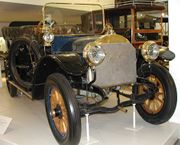
A DMG Mercedes Simplex 1906 in the Deutsches Museum
|
|
1957 Mercedes-Benz 300Sc Cabriolet
|
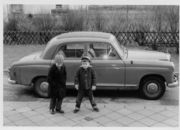
1959 Mercedes-Benz W120 Model 180
|
The two companies which were merged to form the Mercedes-Benz brand in 1926 had both already enjoyed success in the new sport of motor racing throughout their separate histories - both had entries in the very first automobile race Paris to Rouen 1894. This has continued, and throughout its long history, the company has been involved in a range of motorsport activities, including sports car racing and rallying. On several occasions Mercedes-Benz has withdrawn completely from motorsport for a significant period, notably in the late 1930s, and after the 1955 Le Mans disaster, where a Mercedes-Benz 300SLR collided with another car and killed more than 80 spectators. Although there was some activity in the intervening years, it was not until 1987 that Mercedes-Benz returned to front line competition, returning to Le Mans, Deutsche Tourenwagen Meisterschaft (DTM), and Formula One with Sauber.
The 1990s saw Mercedes-Benz purchase British engine builder Ilmor (now Mercedes-Benz High Performance Engines), and campaign IndyCars under the USAC/CART rules, eventually winning the 1994 Indianapolis 500 and 1994 CART IndyCar World Series Championship with Al Unser, Jr. at the wheel. The 1990s also saw the return of Mercedes-Benz to GT racing, and the Mercedes-Benz CLK GTR, both of which took the company to new heights by dominating the FIA's GT1 class.
Mercedes-Benz is currently active in three forms of motorsport, Formula Three, DTM and Formula One.
Formula 1
Mercedes-Benz took part in the world championship in 1954 and 1955, but despite being successful with two championship titles for Juan-Manuel Fangio, the company left the sport after just two seasons.
Mercedes-Benz returned as an engine supplier in the 1990s and part-owned Team McLaren for some years, to which it has supplied engines engineered by Ilmor[44] since 1995. This partnership brought success, including drivers championships for Mika Häkkinen in 1998 and 1999, and for Lewis Hamilton in 2008, as well as a constructors championship in 1998. The collaboration with McLaren has been extended into the production of roadgoing cars such as the Mercedes-Benz SLR McLaren.
In 2007 McLaren and Mercedes was fined a record $100 Million for stealing confidential Ferrari technical data[45].
In 2009, Ross Brawn's newly conceived Formula One team, Brawn GP used Mercedes engines to help win the constructor's championship, and Jenson Button to become champion in the F1 drivers' championship. At the end of the season, Mercedes-Benz sold back its 40% stake in McLaren to the McLaren Group and bought 70% of the Brawn GP team jointly with an Abu Dubai based investment consortium. Brawn GP was renamed Mercedes GP for the 2010 season and is, from this season on, a works team for Mercedes-Benz.
Tuners
Several companies have become car tuners (or modifiers) of Mercedes Benz, in order to increase performance and/or luxury to a given model.
In house
AMG is Mercedes-Benz's in-house performance-tuning division, specialising in high-performance versions of most Mercedes-Benz cars. AMG engines are all hand-built,[46] and each completed engine receives a tag with the signature of the engineer who built it. AMG has been wholly owned by Mercedes-Benz since 1999.[47] On the 2009 IAA in Frankfurt, Germany, Mercedes officially introduced the SLS AMG, a revival of the 300SL Gullwing, and the first car to be entirely developed by AMG.
Aftermarket tuners
There are numerous independent tuners:
- Brabus
- Carlsson
- Kicherer
- Kleemann
- Lorinser
- Renntech
- MKB
- Fluid MotorUnion
Noted employees
- Béla Barényi - car safety pioneer and original designer of the Volkswagen Beetle concept
- Nicholas Dreystadt - Cadillac manager
- Juan Manuel Fangio - considered by many[48] to be the best F1 driver in history [49]
- Wilhelm Maybach - automotive pioneer
- Stirling Moss - F1 driver
- Ferdinand Piëch - Volkswagen and Porsche manager
- Ferdinand Porsche - founder of Porsche
- Rudolf Uhlenhaut - designer of the Mercedes-Benz 300SL
- Bruno Sacco - automotive designer
- Mika Hakkinen - F1 driver, World Champion 1998-1999
- Lewis Hamilton - F1 driver, World Champion 2008
- Jenson Button - F1 driver World Champion 2009
- Michael Schumacher - F1 driver world champion (with other teams) 1994-1995, 2000-2004
- Adolf Eichmann - Nazi Criminal (worked in Argentine division after WWII)
Innovations
Numerous technological innovations have been introduced on Mercedes-Benz automobiles throughout the many years of their production, including:
- The internal combustion engined automobile was developed independently by Benz and Daimler & Maybach in 1886
- Daimler invented the honeycomb radiator of the type still used on all water-cooled vehicles today
- Daimler invented the float carburetor which was used until replaced by fuel injection
- The "drop chassis" - the car originally designated the "Mercedes" by Daimler was also the first car with a modern configuration, having the carriage lowered and set between the front and rear wheels, with a front engine and powered rear wheels. All earlier cars were "horseless carriages", which had high centres of gravity and various engine/drive-train configurations
- The first passenger road car to have brakes on all four wheels (1924)[50]
- The "safety cage" or "safety cell" construction with front and rear crumple zones was first developed by Mercedes-Benz in 1951. This is considered by many as the most important innovation in automobile construction from a safety standpoint[51]
- In 1959, Mercedes-Benz patented a device that prevents drive wheels from spinning by intervening at the engine, transmission, or brakes. In 1987, Mercedes-Benz applied its patent by introducing a traction control system that worked under both braking and acceleration
- Traction control and airbags in the European market, were Mercedes-Benz innovations. These technologies were introduced in 1986, and 1980 respectively
- Mercedes-Benz was the first to introduce pre-tensioners to seat belts on the 1981 S-Class. In the event of a crash, a pre-tensioner will tighten the belt instantaneously, removing any 'slack' in the belt, which prevents the occupant from jerking forward in a crash
- In September 2003, Mercedes-Benz introduced the world's first seven-speed automatic transmission called '7G-Tronic'
- Electronic Stability Programme (ESP), brake assist,[52] and many other types of safety equipment were all developed, tested, and implemented into passenger cars—first—by Mercedes-Benz. Mercedes-Benz has not made a large fuss about its innovations, and has even licensed them for use by competitors — in the name of improving automobile and passenger safety. As a result, crumple zones and anti-lock brakes (ABS) are now standard on all modern vehicles.[51]
- The most powerful naturally aspirated eight cylinder engine in the world is the Mercedes-AMG, 6208 cc M156 V8 engine. The V8 engine is badged '63 AMG', and replaced the '55 AMG' M113 engine in most models. The M156 engine produces up to 391 kW (532 PS; 524 bhp), and although some models using this engine do have this output (such as the S63 and CL63 AMGs), specific output varies slightly across other models in the range[53]
- The (W211) E320 CDI which has a variable geometry turbocharger (VTG) 3.0 litre V6 common rail diesel engine (producing 224-horsepower), set three world endurance records. It covered 100,000 miles (160,000 km) in a record time, with an average speed of 224.823 kilometres per hour (139.70 mph). Three identical cars did the endurance run (one set above record) and the other two cars set world records for time taken to cover 100,000 kilometres (62,137 mi) and 50,000 miles (80,000 km) respectively. After all three cars had completed the run, their combined distance was 300,000 miles (480,000 km) (all records were FIA approved).[54]
- Mercedes-Benz pioneered a system called Pre-Safe to detect an imminent crash - and prepares the car's safety systems to respond optimally. It also calculates the optimal braking force required to avoid an accident in emergency situations, and makes it immediately available for when the driver depresses the brake pedal. Occupants are also prepared by tightening the seat belt, closing the sunroof and windows, and moving the seats into the optimal position.
Half a century of vehicle safety innovation helped win Mercedes-Benz the Safety Award at the 2007 What Car? Awards [50]
Robot cars
In the 1980s, Mercedes built the world's first robot car, together with the team of Professor Ernst Dickmanns at Bundeswehr Universität München.[55] Partially encouraged by Dickmanns' success, in 1987 the European Union's EUREKA programme initiated the Prometheus Project on autonomous vehicles, funded to the tune of nearly 800 million Euros. A culmination point was achieved in 1995, when Dickmanns' re-engineered autonomous S-Class Mercedes took a long trip from Munich in Bavaria to Copenhagen in Denmark, and back. On highways, the robot achieved speeds exceeding 175 kilometres per hour (109 mph) (permissible in some areas of the German Autobahn). The car's abilities has heavily influenced robot car research and funding decisions worldwide.
References
- ↑ 1.0 1.1 Edmunds.com - Mercedes-Benz History
- ↑ http://www.theautochannel.com/news/2005/03/11/010089.html
- ↑ Adams, Bruce A (2007). Mercedes-Benz Club America: 50 years of history, p. 24. Turner P{ublishing Co, Nashville TN USA. ISBN 1-59652-181-3.
- ↑ Behind the Scenes: Mercedez-Benz AMG
- ↑ Mercedes-AMG: unique, top-quality model line-up is popular worldwide
- ↑ The history of Mercedes-AMG GmbH
- ↑ Business Week, November 2006
- ↑ J.D. Power and Associates Reports: Ford Motor Company Captures Most Awards in 2007 Initial Quality Study
- ↑ 9.0 9.1 2008 Initial Quality Study | J.D. Power and Associates
- ↑ "Reliability trends, reliability findings". Consumerreports.org. 24 March 2009. http://www.consumerreports.org/cro/cars/used-cars/reliability/best-worst-in-car-reliability-1005/reliability-findings/reliability-findings.htm. Retrieved 26 April 2009.
- ↑ A huge fine for Mercedes-Benz for poor fuel efficiency by Jeremy Korzeniewski on 8 January 2009, AutoblogGreen
- ↑ http://www.epa.gov/fueleconomy/guzzler/420b08016.pdf
- ↑ "Car company CO2 Report for 2008". Transport & Environment. http://www.transportenvironment.org/Publications/prep_hand_out/lid:549. Retrieved 21 October 2009.
- ↑ "Car company CO2 Report for 2007". Transport & Environment. http://www.transportenvironment.org/Publications/prep_hand_out/lid/513. Retrieved 24 November 2008.
- ↑ /// Mercedes-Benz Argentina ///
- ↑ Martin, Norman (1999). "Going, Going, Graz". Automotive Industries. http://findarticles.com/p/articles/mi_m3012/is_10_179/ai_57513425.
- ↑ DaimlerChrysler
- ↑ "Mercedes-Benz Plant Kecskemét". Daimler-Benz. http://www.daimler.com/dccom/0-5-8792-1-1207457-1-0-0-0-0-0-91-7155-0-0-0-0-0-0-0.html. Retrieved 15 October 2009.
- ↑ "Germany: Daimler Selects Plant Site". New York Times. 19 June 2008. http://www.nytimes.com/2008/06/19/business/worldbusiness/19fobriefs-DAIMLERSELEC_BRF.html?emc=eta1. Retrieved 15 October 2009.
- ↑ Mercedes-Benz India - Passenger Cars Homepage
- ↑ Mercedes-Benz Indonesia - Passenger Cars homepage
- ↑ DaimlerChrysler Malaysia
- ↑ Anambra Motor Manufacturing Company Ltd
- ↑ South Africa's automotive industry - SouthAfrica.info
- ↑ "Thonburi Group:Serving the Thai market for more than six decades". http://www.thonburi.com/thonburigroup_en.php. Retrieved 15 October 2009.
- ↑ Mercedes-Benz Türk A.Ş
- ↑ http://mbusi.com/pages/products_home.asp
- ↑ Automobile Magazine
- ↑ Mercedes vehicles at the 2007 Frankfurt show
- ↑ A hybrid drives Mercedes concept
- ↑ Healey, James R. (23 March 2008). "Mercedes sees electric-car progress". USA Today. http://www.usatoday.com/money/autos/environment/2008-03-23-mercedes-electric-car-battery_N.htm. Retrieved 12 May 2010.
- ↑ "Mercedes-Benz S 400 BlueHYBRID: CO2 Champion in the Luxury Class with Efficient Hybrid Drive System and Lithium-Ion Technology | Daimler > Brands & Products > News". Daimler AG. 17 September 2008. http://www.daimler.com/dccom/0-5-633234-1-1129030-1-0-0-0-0-0-9293-7163-0-0-0-0-0-0-0.html. Retrieved 26 April 2009.
- ↑ Abuelsamid, Sam (29 February 2008). "Mercedes-Benz S400 BlueHybrid, first production lithium ion hybrid". AutoBlogGreen.com. http://www.autobloggreen.com/2008/02/29/mercedes-benz-s400-bluehybrid-first-production-lithium-ion-hybr/. Retrieved 26 April 2009.
- ↑ "Mercedes enters the hybrid game - the S400 BlueHybrid". AutoUnleashed.com. http://www.autounleashed.com/mercedes-enters-the-hybrid-game-the-s400-bluehybrid. Retrieved 26 April 2009.
- ↑ 2007 IAA Report - S-Class hybrid
- ↑ "Mercedes-Benz Concept BlueZERO: Modular Drive Concept for Electric Vehicles | Daimler > Technology & Innovation > News". Daimler AG. 15 December 2008. http://www.daimler.com/dccom/0-5-7153-1-1160703-1-0-0-0-0-0-9293-7145-0-0-0-0-0-0-0.html. Retrieved 26 April 2009.
- ↑ "Mercedes-Benz BlueZero Concept (2009) with pictures and wallpapers". NetCarShow.com. http://www.netcarshow.com/mercedes-benz/2009-bluezero_concept/. Retrieved 26 April 2009.
- ↑ "The Ultimate Posting on Plug-In Hybrid Developments: Clip & Save". Calcars.org. http://www.calcars.org/calcars-news/1072.html. Retrieved 17 December 2009.
- ↑ http://www.elektromotive.com/html/news-story.php?news_id=59
- ↑ http://green.autoblog.com/2010/07/30/mercedes-benz-introduces-new-vito-e-cell-van/
- ↑ Mercedes-Benz presents the innovative Automatic Bike
- ↑ [1]
- ↑ [2]
- ↑ "Ilmor: Bowmen of the Silver Arrows". Atlasf1.autosport.com. http://atlasf1.autosport.com/2001/jan03/tytler.html. Retrieved 26 April 2009.
- ↑ "FIA: $100M fine handed to Mercedes". FIA. http://www.fia.com/mediacentre/Press_Releases/FIA_Sport/2007/September/130907-02.html. Retrieved 26 April 2009.
- ↑ Mercedes-Benz Ireland - New cars - AMG
- ↑ History of AMG
- ↑ "The official Formula 1 website". Formula1.com. 24 June 1911. http://www.formula1.com/teams_and_drivers/hall_of_fame/268/. Retrieved 26 April 2009.
- ↑ Enciclopedia Britannica
- ↑ 50.0 50.1 Magazine
- ↑ 51.0 51.1 Mercedes-Benz Safety Innovations
- ↑ Mercedes Introduces PRE-SAFE Brake Safety System Posted on 22 June 2006, The Unofficial Mercedes-Benz Weblog
- ↑ Mercedes-AMG 6.2-litre V8 Engine : News & Reports : Motoring : Web Wombat
- ↑ New Mercedes Diesel Engine Breaks World Endurance Record
- ↑ Highlights of robot car history with emphasis on S-Class robot car of 1995 by Ernst Dickmanns by Jürgen Schmidhuber, 2005
External links
- Video clips
| Class | Model | Body | 1980s | 1990s | 2000s | 2010s | |||||||||||||||||||||||||||
| 0 | 1 | 2 | 3 | 4 | 5 | 6 | 7 | 8 | 9 | 0 | 1 | 2 | 3 | 4 | 5 | 6 | 7 | 8 | 9 | 0 | 1 | 2 | 3 | 4 | 5 | 6 | 7 | 8 | 9 | 0 | |||
| Small | A | Hatch | W168 | W169 | |||||||||||||||||||||||||||||
| Small | B | W245 | |||||||||||||||||||||||||||||||
| Compact | C | Saloon | W201 | W202 | W203 | W204 | |||||||||||||||||||||||||||
| Estate | S202 | S203 | S204 | ||||||||||||||||||||||||||||||
| Executive | E | Saloon | W123 | W124 | W210 | W211 | W212 | ||||||||||||||||||||||||||
| Limousine | V123 | V124 | V212 | ||||||||||||||||||||||||||||||
| Estate | S123 | S124 | S210 | S211 | S212 | ||||||||||||||||||||||||||||
| Luxury | S | Saloon | W126 | W140 | W220 | W221 | |||||||||||||||||||||||||||
| Limousine | V126 | V140 | V220 | V221 | |||||||||||||||||||||||||||||
| Pullman | W100 | VF140 | VF220 | VF221 | |||||||||||||||||||||||||||||
| Landaulet | A140 | ||||||||||||||||||||||||||||||||
| Compact | CLC | C | Coupé | CL203 | CL203 | |||||||||||||||||||||||||||||
| Executive | CLK | E | C123 | C124 | C208 | C209 | C207 | |||||||||||||||||||||||||||
| Cabriolet | A124 | A208 | A209 | A207 | |||||||||||||||||||||||||||||
| CLS | Coupé | W219 | |||||||||||||||||||||||||||||||
| Luxury | CL | C107 | C126 | C140 | C215 | C216 | |||||||||||||||||||||||||||
| Sports | SLK | Roadster | R170 | R171 | |||||||||||||||||||||||||||||
| SL | R107 | R129 | R230 | ||||||||||||||||||||||||||||||
| Exotic | SLS | Coupé | C197 | ||||||||||||||||||||||||||||||
| SLR | C199 | ||||||||||||||||||||||||||||||||
| Roadster | R199 | ||||||||||||||||||||||||||||||||
| Speedster | Z199 | ||||||||||||||||||||||||||||||||
| Small | Vaneo | MPV | W414 | ||||||||||||||||||||||||||||||
| Executive | Viano | W638 | W639 | ||||||||||||||||||||||||||||||
| Luxury | R | V251 | |||||||||||||||||||||||||||||||
| Compact | GLK | SUV | X204 | ||||||||||||||||||||||||||||||
| Executive | M | W163 | W164 | ||||||||||||||||||||||||||||||
| Luxury | GL | X164 | |||||||||||||||||||||||||||||||
| Utility | G | W460 | W461 | ||||||||||||||||||||||||||||||
| W463 | |||||||||||||||||||||||||||||||||
| Vito | LCV | Vito | Vito | ||||||||||||||||||||||||||||||
| Sprinter | T1 | W901 - W905 | NCV3 | ||||||||||||||||||||||||||||||
| Vario | T2 | T2 | W670 | ||||||||||||||||||||||||||||||
|
|||||||||||||||||